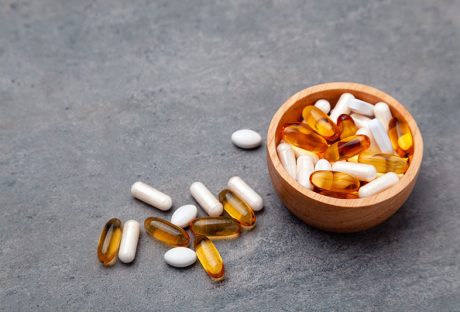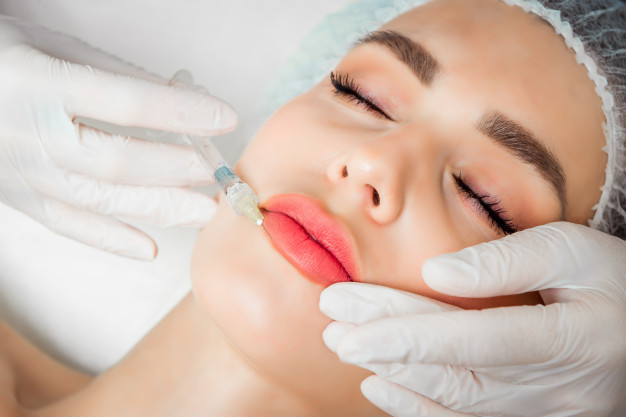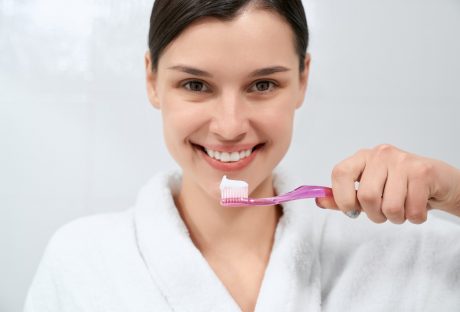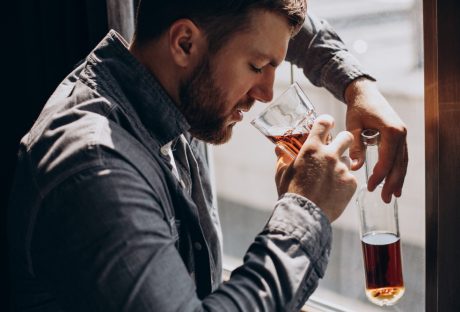Category: Health & Fitness
ContentRally is a leading source of reliable news and trending topics on Health Fitness. Get hard-to-find insights and advice on Health Fitness from industry-specific leaders.

8 Natural Ways to Balance Hormones
Did you know that every day your body is sending complex chemical messengers called hormones to regulate its systems? Often times, we think our hormones negatively, but these natural compounds are essential to the health of both men and women. The most common types of hormones include cortisol, melatonin, progesterone, testosterone, estrogen, adrenaline, and insulin. Without any of these, our bodies wouldn't be able to function properly. Hormones can impact everything from digestive health to mental health, and they are intimately involved in the reproductive cycle. As important as they are, dysfunction can easily occur at different points in the production and circulation of hormones. It is vital to understand how to combat these issues in a natural way. Read on to learn more about the endocrine system's inner workings, as well as natural ways to balance hormones. How the Endocrine System Works: The endocrine system is essentially made up of several glands that produce the different types of hormones found in your body. To name the major ones, these are the pituitary, pineal, thymus, thyroid, adrenal glands and pancreas. The testes and ovaries are also involved, depending on your sex. Understanding the basis of this system can help you understand what can go wrong, and how to promote better hormone health. Firstly, there are key ingredients that are needed to produce hormones. These include fats, proteins, and various nutrients. As well, toxins can disrupt hormones by either mimicking them or suppressing their production in some form. All and all, the entire endocrine system works in unison to promote the normal functioning of your body. Even the slightest imbalance can lead to symptoms. Signs of Hormone Imbalance: There are a few keys signs of hormone imbalance to be aware of, as both a male and female. In women, problems around the menstrual cycle are often the most obvious sign of an imbalance. Infertility, irregular periods, skin issues, and premenstrual syndrome can all signify issues with the endocrine system. Additional symptoms that can manifest in both sexes include fatigue, anxiety, depression, low libido, insomnia, digestive issues, hair loss, and weight problems. Natural Ways to Balance Hormones: With the impact that hormones can have on the body, promoting their balance in your daily routine is essential. Natural options are much more favorable than synthetic ones such as birth control or other artificial hormone medications. These do not get to the root of your health issues. They merely cover them up, and symptoms can get worse or more can occur in the meantime. As an alternative to treatments that do not get to the bottom of your problems, here are eight natural ways to balance hormones. 1. Avoid Endocrine Disruptors: Endocrine disruptors are abundant in our industrialized world. These are chemicals and compounds that interfere with hormonal processes in the endocrine system. A few well-known endocrine disruptors include BPA, dioxin, phthalates, and certain pesticides. The items we use in our homes can often contribute to our overall toxin load, and switching over to healthier alternatives can be greatly beneficial. Choose non-toxic cleaning products whenever possible, and try to avoid using plastics in the kitchen as much as possible. As well, our beauty products can also be a potential source of exposure. Use the environmental working groups website to help you pick better products for your hormones. Lastly, eating organic produce whenever possible will reduce your consumption of pesticide residue. 2. Limit Caffeine: Caffeine is a big part of most of our lives, and it is difficult to part with. But, in truth, it can have detrimental effects on our hormones. Highly-caffeinated beverages, namely coffee, can put our bodies into a permanent state of fight-or-flight by stimulating the production of stress hormones. While this may be beneficial in the short term, it can stress your entire body out in the long-term. Consider cutting back on your caffeine intake, or swapping it out entirely for drinks with lower levels of caffeine. 3. Eat Healthy Fats: Many hormones are cholesterol-based, meaning that fat is the basis of their make-up. Therefore, eating plenty of healthy fats will help your body produce enough of these hormones. Ensure that you focus on saturated fats and omega-3's especially, as our diets tend to be too high in omega-6's. 4. Sleep is Key: Sleep is the time when our bodies produce hormones and detoxify harmful substances from our body. Moreover, sleep can disrupt your mood and your blood sugars levels, both of which can contribute negatively to hormones. Try to optimize your sleeping environment by making the room as dark as possible and creating a nighttime routine. 5. Exercise Properly: While exercise is always important, extended periods of exertion can actually have negative consequences. Therefore, opt for less strenuous workouts such as weight lifting or gentle yoga when you first begin your healing journey. 6. Try Mindfulness: Stress is often at the root of our hormone problems. In the least, it can make your moods and physical symptoms much worse. To complicate things, stress is not an easy problem to 'fix'. Often times, it is anything but easy to reduce our stress levels. One option to try, however, is to implement mindfulness into your approach. It will not only help you become more aware of your body and its struggles but also to how you deal with adversity. Over time, you can begin to shift your mindset around the stresses of life with mindfulness and develop a better relationship with it altogether. 7. Consider Herbs or Supplements: Another potential way to heal your endocrine system is with different herbs and supplements. These are not a quick fix by any means, but they can provide additional support alongside other treatments. Some good options for supplementation could include red raspberry leaf, evening primrose oil, vitex, maca, fish oil, magnesium, and zinc, depending on your specific imbalance. 8. Try Bio-Identical Hormones: There are times when no amount of natural treatment through sleep, diet, and exercise help. In this case, an option could be bio-identical hormone therapy, which involves using chemically identical hormones to heal your imbalance. BodyLogicMD has an abundance of information on this topic and can help provide you the support you need. Hormone Health Reflects Overall Health: All in all, the health of our endocrine system is reflective of our lived environment. While it can be influenced partly by genetics and other factors out of our control, much of it is impacted by the way we choose to live. Therefore, by consciously choosing to implement natural ways to balance hormones, we can reap the benefits of our system working in our favor. For more information about how hormones can impact reproductive health, check out our post of the causes of female and male infertility. Read More: Must-Have Appliances for a Healthier Life. Important Habits to Protect Your Ear Health and Hearing. How to Stay Healthy and Fit Despite a Hectic Schedule.
READ MOREDetails
5 Things You Should Do To Reduce Stress
Stress is one of those conditions you wouldn't want to be in because apart from its manifestations that can range from mild to severe headaches, it can be completely disruptive. It can put your productivity in jeopardy and saneness into disrepute. People who have had to deal with stress can attest to the fact that it is also hard to socialize. When stress invades your life, even eating becomes a challenge because appetite, even for the most sumptuous meal, will be out of the window, and you just want to be left alone. While you can consider https://customwriting.com/write-my-essay to help you do a post on your situation as a way of stress relief, there are other approaches. In this post, I share with you tips on how to deal with stress, but first, What causes stress? Whether it catches up with you at home, or at the workplace, types of stress vary depending on the cause. The following are some of the most common: The pressure at the workplace. Employees sometimes slump into anxiety because there is a lot to do with a strict timeline. It is to say; when it becomes clear that one will not be able to meet a set deadline, stress sets in. Loss of a loved one, through separation, death or in any way. Health conditions such as sickness are a major cause of worry. While patients need to cheer up no matter their situations, diseases like cancer are sure to cause one unimaginable level of stress. Discrimination at school, workplace, and other places. Emotional and physical abuse Common stress symptoms include the following: Tension headaches Depression in the worst cases Insomnia or lack of sleep Anxiety/fear of the unknown Muscle pains Gastrointestinal refluxes/upset Thus far, the next question most people who exhibit these symptoms ask is how to reduce stress so as to become active again, jovial and productive. Well, studies on stress management suggest different approaches. The following tips will go a long way in helping one recover from any of the above conditions: 1. Take care of yourself : If you cannot take good care of yourself, then who will? It is the first question stressed persons need to ask before embarking on a path of recovery. Also, what does self-care entail? It is important to feed on a healthy diet, get enough sleep and partake in physical exercises. Studies have indicated that those who do these reduce stress levels in their lives, almost completely. 2. Meditate : There is no way you are going to get away from stress if meditation is not one of the foremost solutions. For those who do not know how to partake in thoughtful awareness, it basically involves sitting silently in a quiet room with one hand on the belly, legs folded or straightened, then listen to the sound of the heartbeat. There are however many other productive meditative approaches people who want to deal with stress can explore. According to research, when you meditate, there occurs an alteration in the pathways of brain neurons, something that makes you feel relaxed and peaceful. 3. Do away with negative energy : If the cause of your worries and anxiety is negativity, then a journey to recovery should start with doing away with people who bring negative energy into your life. Life should be fun, and it all starts with finding people who put a smile on your face. 4. Design a healthy life-work balance : There is no way you are going to be happy if work takes away all the time you have in the world. People need time for their families, in which case, it starts with knowing how to design the life you want. Come to think about it. What value does being a career addict who is obsessed with deadlines and never has for family and plays bring? It only begets stress. 5. Enjoy your hobby : One of the best approaches to fighting stress is sporting. If you love to play football, go out and enjoy it in the evenings after work. Dance to your favorite music tunes, or watch a favorite movie series. Hobbies keep your mind busy, and by extension, help in releasing endorphins hormones that will make your face glow once again. In summary, managing stress starts with you, and ends with making the right decision. A psychotherapist will only advise but it is incumbent upon you to execute. Read Also : Unhealthy And Healthy Solutions For Coping With Stress
READ MOREDetails
The Top 10 Best Foods to Eat in Early Pregnancy
Good news ladies, pregnant women need to eat an extra 350 to 500 calories each day. Finally, a valid excuse to eat more! With that statistic in mind, we thought it would be a good idea to reveal to you the best foods to eat in early pregnancy. That way, you'll be able to use this surplus of calories to both you and your babies advantage. So, without further ado, let's dive in! 1. Beans and Lentils : If you're looking to nurture your 14 weeks pregnant belly, we recommend eating plenty of beans and lentils. These foods are a fabulous source and protein, and pregnant women need an extra 10 grams of protein each day. Therefore, beans and lentils make an excellent addition to your diet because they contain as much as 15 grams of protein per cup! If you're unsure how to use them, we suggest adding cooked lentils and beans to your salads and rice dishes. These are sure to be a tasty addition! 2. Broccoli : Now, broccoli isn't always everyone's favorite food. However, it's worth bearing with because it's packed full of nutrients such as calcium and folate. In addition to this, it's high in fiber and vitamin C which is essential for helping your body absorb iron. Therefore, the best time to eat broccoli is when you accompany it with iron-rich food like lean red meat or wholegrain pasta. Plus, broccoli is rich in antioxidants, which promote healthy digestion and strengthen your immune system (which is obviously even more critical when you're pregnant). Also, if you're struggling with constipation (which is exceptionally common among pregnant women), broccoli is a must because of its high fiber content. Really and truly, broccoli is the perfect pregnancy food! 3. Bananas : Bananas are a brilliant snack for pregnant women. Not only does the potassium help combat fatigue, but they're also kind on the stomach if you're suffering from morning sickness. 4. Lean Meat : Just like protein levels, pregnant women also need to increase their iron intake. The volume of their blood increases, which causes them to need double the amount of iron. Therefore we suggest eating plenty of lean meat as this provides a form of iron that's quickly absorbed by the body. Good examples of these include: Beef Pork Chicken In addition to iron, these meats typically contain choline and vitamin B, both of which pregnant women need more of. 5. Oatmeal : There's no better to start your day than by eating a bowl of nutritious cereal. The complex carbohydrates in oatmeal will leave you feeling fuller for longer, and this breakfast will help lower your cholesterol levels--win-win! Top Tip: Don't buy processed oatmeals that are full of sugars and additives. Instead, cook yourself the plain variety and add a dollop of jelly. Yummy! 6. Leafy Greens : When you cook the following greens: Spinach Kale Turnip greens You release higher levels of iron and folate. In addition to this, they're also a fabulous source of calcium, vitamin C, vitamin K, vitamin A, and potassium. We suggest sprinkling a few of these leafy greens in your pasta dishes, adding them to soups, or substituting iceberg lettuce for them in your salads. 7. Whole-Grain Bread : The simple swap from white to whole grain can make a massive difference when you're pregnant. By doing this, you ensure you get your daily intake of fiber. Ideally, you want to ensure that each slice contains at least two grams of fiber before you commit to purchasing the loaf. Plus, wholemeal bread also provides you with both iron and zinc, which are both essential nutrients for pregnant women! 8. Oranges : Oranges are an excellent fruit to eat while you're pregnant. They're full of the following goodies: Vitamin C Folate Fiber Water Now the water might not sound like a massive deal, but these fruits are almost 90% liquid, which is excellent for keeping you hydrated and combatting fatigue. 9. Nuts and Nut Butters : Healthy fats are critical for your baby's brain development, so we suggest eating one ounce of nuts a day and two tablespoons of nut butter. Plus, these snacks will help keep you full! Top Tip: if you suffer from any kind of allergy, we suggest steering clear of highly allergenic foods such as nuts while you're pregnant. Some scientists believe that exposing the baby to foods like this during pregnancy could increase their risk of developing a more severe allergy during childhood. 10. Sweet Potatoes : Sweet potatoes are full of a nutrient called beta-carotene. When we digest it, we transform it into vitamin A. This is fabulous for mothers to be because Vitamin A helps the fetus' cells grow and differentiate from one another. Top Tip: pregnant women are usually advised to stay away from high levels of animal-based vitamin A because these can sometimes be dangerous when eaten to excess. This is another reason why foods that contain beta-carotene are essential to include in your pregnancy diet. Best Foods to Eat in Early Pregnancy: Final Thoughts It's important for women to swot up on the best foods to eat in early pregnancy because your dietary requirements change a little. However, by sticking to diets high in protein, iron, and fiber, you shouldn't go too far wrong! If you enjoyed this article, we're confident you'll love the other features published on our family and parenting blog. Over there we discuss everything from pregnancy care tips to family leave. Enjoy! Alternatively, if you have any questions about this subject, please feel free to drop us a line. We love to hear from our readers! Just fill out the simple contact form, and we'll get back to you as soon as we can. Speak soon! Read Also : Choosing The Best Mattress That Will Make Mothers Comfortable During Pregnancy Golden Pregnancy Care Tips For All Expectant Women 9 Tips For Staying Fit And Healthy During Pregnancy
READ MOREDetails
Things to do before bed for a perfect night’s sleep
Good sleep is usually described as how a baby sleeps. A baby is likely to enjoy quality sleep because they have no worries or anything that could hinder that perfect sleep. However, as you grow up, sleep quality tends to deteriorate because of different factors associated with adulthood. It is very important to have enough and good sleep as it has a significant effect on your body in terms of health and general activeness. You need to adopt the habit of sleeping early and having uninterrupted sleep time for about 7-9 hours every night. What should you do before bed to have a good night's sleep? Tidy your room. Study shows that people with clean and decluttered rooms tend to sleep better than those whose rooms are untidy and unkempt. Make your bed, fold your clothes and keep your room in order. Finish up your daily chores. Once the day is over, you should have finished everything you had planned for that day. Wash that blue cantilever umbrella you had planned to by the end of the day. By doing so, your mind will be able to relax when you get into bed. Eat dinner early. Most people will have their meals so late in the night that they end up sleeping late. It is better to eat early so that you can give the food time to digest. Doing that will actually help you sleep better. Make your bed comfortable. This includes changing your bedsheets into clean ones and getting the right sized pillow and mattress. You should also get s blanket that will shield you from the cold at night and is soft to your body as well. Take a warm bath. This helps to cool off your body and prepare it for sleep. Bathing with warm water will get your body temperature going down when you step into the cool bedroom from the shower. That helps induce sleep. Set the room temperature. You do not want a room that is too hot to sleep in or too cold that you cannot sleep. Regulate the temperature to what you feel is comfortable for you. Organize your thoughts. Going to bed with a lot of unorganized thoughts will keep you up for hours. Make sure you write down anything disturbing you and try to find a solution before you can sleep for better sleep quality. Switch off electronics. Things like phones, laptops, and TV should be switched off 2 hours to sleeping time. The blue light produced by these gadgets is not so good for your eyes when you want to sleep. Eat cherries. As I said, you should not eat right before bed. However, you can snack on some cherries as they are natural sources of melatonin which is a sleep-inducing hormone. Block any light from outside. You could switch off your electronics but there is still light coming from the outside. Total darkness is the recipe for sleep. Use dark and heavy curtains to block any light coming from the outside. Read a book. This is a good way to spend the last minutes before bed. Make sure the book does not require a lot of intellectual engagement and neither is it too exciting to take away your sleep. Listen to soothing music. There are people who cannot sleep in total silence. If you're one of these people, get some soothing music and play it in low tones right before you sleep. Spray some lavender scent into your room. Lavender is associated with having a calming and sedentary effect on you. It will help you sleep much faster and better. Conclusion : Don't deny yourself the opportunity to sleep better by ignoring some of these things that are necessary for a good night's sleep. In fact, these things are very easy to do and they can have a tremendously positive effect on your sleep life. Observe each one of them and make it a routine before you go to bed. Within a month or so, your body will have adapted to the change and you won't have to keep a reminder anymore. You'll be doing these things naturally. Invest in good sleep and your body will thank you for it. Make sure that everything is done to your preference for an easy time. Read Also : 5 Ways To Make A Big Statement In Small Bedroom 3 Tips On How To Plan The Best Cheap And Fabulous DIY Bedroom Makeover 5 Innovative Ideas To Lend Your Bedroom With More Space
READ MOREDetails
A Loved One Addicted to Opiates? Here Are Common Signs
If you've been paying attention to the news, you already know that the opioid crisis in the United States has reached critical mass. In some areas, opioid overdoses increased by 70 percent in just over a year's time. The opioid epidemic now touches the lives of millions of everyday Americans. As a result, the chances that you know someone with opioid addiction have increased astronomically. For anyone concerned that their loved one might have a problem, it's important to recognize the early warning signs of opiate use. That's what this article is for. Below, you'll learn a few basic things to look for when trying to determine if a loved one has an opiate problem. With any luck, you won't need this information, but preparedness and awareness are always important. Physical Signs of Opiate Use : When dealing with opioid abuse, there are two major categories symptoms can fall into: physical and behavioral. Let's tackle the former first. One major and obvious physical warning sign to look for is needle marks. Often, an addict will start to use drugs intravenously, which means they're injecting it. This will usually leave clear signs of use at the injection point, which is very often the major artery in the arm. Beyond the clear physical appearance of abuse, addicts will often suffer from other physical ailments. One prominent side effect is "nodding," which means that the user falls asleep suddenly and at inappropriate times. If your loved one frequently drifts off mid-conversation, this can be a sign there is a more serious problem under the surface. Other than the two unmistakable signs above, physical signs of opioid use are hard to spot. Other symptoms like constricted pupils and flushed skin can be attributed to many other things, so it's best not to worry about them alone. However, if they're paired with needle marks and nodding, there is cause for concern. Behavioral Signs of Opiate Use : The behavioral side effects of opioid abuse can be tough to spot because they closely resemble side effects caused by other common ailments like depression, stress, and anxiety. But since they're so often paired with physical signs, you'll most likely be able to tell the difference. Withdrawing from social activities is a big early warning sign. If your loved one suddenly retreats from social groups or things they once enjoyed doing, it can be a sign of a much bigger problem. Isolation is one of the earliest and most clear indicators that something is up. Mood swings and drastic behavior are also something to look for. If someone is acting highly out of character, breaking the law, and engaging in unusually high-risk behavior, something is probably wrong. All in all, behavioral shifts can be hard to hone in on, but drastic changes are almost certainly a sign of something worse. Even if it isn't an opioid addiction, it's always worth checking in with a loved one if their behavior changes unexpectedly. There are treatment centers like SMC Recovery that specialize in opiate addiction rehabilitation. Reaching out to a facility such as this can provide you with the resources and expertise you need to determine if your loved one requires medical follow-up. What's Next? Now that you're familiar with some basic signs of opiate use, you can stay vigilant when it comes to keeping loved ones safe. Addiction is a notoriously difficult problem, but there's always hope. People recover every day. If you or a loved one has an opiate problem, don't give up. With the help of professionals, friends, and family, no obstacle is too tall to scale. Stay strong, and with a little help, recovery is well within reach. Follow our blog for more health-related news and updates. Read Also : 5 Reasons Why It’s Not Too Late To Get Help Effects Of Sleep Deprivation On Your Skin & Good Sleeping Habits
READ MOREDetails
Important Habits to Protect Your Ear Health and Hearing
Hearing loss isn't always something that can be prevented. Sometimes loss of hearing is just something that happens as you get older. But in an increasingly loud and busy world, hearing loss might be caused early or worsened by the environment around you. And once you're hearing is gone, it can be gone for good. Can you imagine life without being able to hear? It's a scary thought for many and should be. And yet, very few of us take the proper precautions in protecting our ears and our hearing. That changes now. If you're committed to the concept of ear health and protecting your hearing, read on. We'll discuss several ways to help ensure that your hearing stays strong and true for many years to come. The Case For Earplugs : You likely rolled your eyes back in your youth when your parents advised you to wear earplugs to that rock and roll concert. But they were on to something. Approximately 15% of Americans lose hearing as a result of too-loud work or leisure environments. If you work or spend lots of time in an environment where the sound level forces you to shout to be able to communicate, it's likely that the sound levels there are dangerously high. This loudness could be due to a concert or club, or even more often, due to some form of loud and consistent machinery. If you know that you spend many hours around this kind of noise level, you should absolutely invest in a good pair of earplugs. Earplugs are easy to obtain, generally affordable, and can even be made individualized for your ears upon request. They can dampen the level of sound coming in from your environment by a significant margin, helping to curb the possible loss of hearing. Keep The Volume Low : According to the World Health Organization, over a billion people each year are at risk of hearing loss due to the unsafe use of audio devices. Earbuds, like the popular headphones designed by Apple, are especially dangerous for ear health as they fit directly into the eardrum. If you're a music lover, you probably spend a lot of time listening to music on headphones. If you care about the health of your ears, though, you should make an effort to keep the volume at a lower level. Doctors recommend a philosophy they've dubbed the 60/60 rule. The rule is a recommendation that you listen to music through headphones at 60% volume for less than 60 minutes a day for the benefit of your hearing. Even when not listening to headphones, you should aim to keep music played at a normal level to ensure long-lasting ear health. Avoid Cotton Swabs : One of the most common items in any household bathroom cabinet is a jar of cotton swabs. These little tools have been used by people to clean out ear wax for years and years, but it's only more recently that their nefarious reputation has begun to reach the public. It actually turns out that a little wax in the ears is both healthy and normal. Ears are self-cleaning organs and the wax in your ears actually serves to prevent dust and other particles from entering your eardrum. If you do have excess wax, it is not advisable that you use a cotton swab. You can very easily damage your eardrum by using a cotton swab. Instead, considering using a damp towel to gently clean around the canal. There are also various ear wax solutions that are available in stores. These are applied to the ears overnight and can help to dissolve and soften ear wax so that it can flow out of the inner ear on its own. Keep Your Ears Dry : Another frequent cause of ear damage is extra moisture. Excess moisture can allow bacteria to enter the ear canal and cause serious problems, such as a swimmer's ear or other infections. Following swims at the pool or beach, showers or baths, or any other water-related activity, you should be sure to gently towel-dry your ears. If you can feel the moisture in your ear following swimming or bathing, tilt your head to the side and tug lightly on your eardrum to help water drain out. There are also specially designed swimmer's earplugs available on the market, which can help prevent water from entering your eardrum during a swim. They work great for any age, kids or adults, and can be individually fitted for your ear by a licensed physician. Consider Getting Regular Check-Ups : Especially as you get older, you should ask your physician to incorporate hearing screenings into your regular checkups. Hearing loss doesn't happen in a flash of light, it is a very gradual process. It's recommended, then, that you have yearly consultations with a hearing healthcare professional, who can recognize the signs of hearing loss while it is still in the early stages. Taking action against hearing loss is important, as is discussing it with your doctor. Loss of hearing has been linked to other health concerns such as depression, dementia, and heart disease. Establishing a relationship with your doctor in regards to ear health early on can contribute to better overall health later on. If you do find yourself losing hearing, you should ensure to invest in a proper hearing aid. With all the advances in rechargeable hearing aids over the past few years, they now serve people with hearing impairment much better. A well-designed hearing aid can help improve the quality of life for someone who has lost hearing and can stave off the other health issues previously mentioned. If you're interested in the best hearing aids on the market, you can learn more here. Read Also : 5 Dental Hygiene Tips For A Healthier Smile Essential Health Benefits Of Coconut Oil Must-Have Appliances For A Healthier Life
READ MOREDetails
Lip Fillers: 7 Essential Factors To Consider Before You Start Using
A study by the American Society of Plastic Surgeons estimates that a cosmetic lip injection is performed once every twenty minutes. That’s once every episode of New Girl, not including the credits or title sequence! To learn basic details about lip fillers, read on to the end of the article. What Are Lip Fillers? With the help of lip fillers, you can increase the volume of your lips. These come in the form of injections with dermal fillers. Actually, they consist of synthetic hyaluronic acid (HA). This is actually a natural substance inside the human body. Some common lip filler brands are Restylane, Juvederm, and Perlane. Benefits Of Lip Fillers The following are some of the major benefits of lip fillers: Lip fillers add volume to your lips, which goes away as you age. The symmetry between your upper and lower lips gets better. The wrinkles and fine lines around your mouth will go away. Also, lip fillers will give a youthful appearance to your lips. As a result, it improves your self-image and confidence. You will get natural-looking results without the need for surgery. However, the results are temporary. Hence, you can try out different shapes and volumes without committing permanently. One of the best things about lip fillers is that you can resume your normal activities immediately after the treatment. In fact, you do not need recovery time for it. However, if the results after treatment do not satisfy you, you can dissolve it with an enzyme that dissolves HA-based fillers. Top 7 Things You Must Know About Lip Fillers Lip fillers are, of course, super common. They’re also super precise, low-key, and effective. Maybe you’re thinking of sliding under the needle yourself, or maybe you’re just trying to tear yourself away from your ninth consecutive ‘side of KUWTK. Either way, there are some things you should know about lip fillers. Here are 7 of them. 1. Prep For Lip Fillers Matters: Maybe this seems like a no-brainer–but if you’re looking to have an awesome experience with lip fillers and enhancement, it’s worth noting. Although lip injections have become a really common procedure (thanks, Kylie!), it’s still not a one-size-fits-all sort of deal. It’s essential that you consult carefully with your doctor to ensure you’re clear on your personal lips’ limitations and potentials. On your end of the deal, it’s important to consider your own expectations and desired outcomes. Although lip injections have become pretty low-key, it’s still necessary to decide for yourself the sort of impact you want your new lips to have on you and your face. For additional preparation, specialists suggest abstaining from painkillers like aspirin, Motrin, and Aleve, as well as fish oil, multivitamins, and vitamin E. Each of these acts as a blood thinner and can serve to make recovery more…bruises. 2. Different Fillers Do Different Things: You can expect to pay anywhere from $400 to $1000 for your fillers. The actual numbers depend on a few different things, including specific location and practice. Price can also depend on the particular type of injections you choose. People typically choose between Collagen or Hyaluronic Acid (HA) bases as their filler material. Collagen works simply by plumping the lip through its presence. HA, on the other hand, plumps the lip directly while also trapping water within the lip. There are several different brands and forms of HA that can have various effects. For example, a filler such as Juvederm (s/o to Kylie!) will usually result in a really soft, youthful–let’s just say it–Kylie Jenner-esque pout. Other fillers, like Restylane or Volbella, utilize smaller particles to achieve a subtler plump. It’s important to talk with your surgeon and decide together which of the potential fillers will work best for your lips, goals, and budget. 3. Lip Shapes Depend On Your Face: You can bring as many close-ups of Kylie’s bottom lip to your surgeon as you want–but nothing can really guarantee the precise way your lips will look after the fact. Sure, the specific type of injection you go with can have some impact on the outcome of your lips’ shape, but it all comes down to your face’s natural set-up and allowances. Lip injections typically work better on people with naturally fuller lips (lame, we know), and the way your lips look once they’re healed really does have a lot to do with how your face moves with your injection. The downside is that it’s nearly impossible to “copy” someone’s lips. But the plus side of this fact is that your lips will probably come out looking more natural and fitted to your face. They’re still your lips, just…fuller. 4. You Can Handle The Pain: Maybe you, like a lot of people, aren’t super keen on needles. Or pain. Or needles. Surprise! There’s no magical way to administer lip injections without injecting the lip (although we wish there were). If you want fuller lips, the fact is, you’ll need to undergo the needle. The cool thing about lip injections, though, is that your lips are put under–a numbing cream, that is. The salve is applied generously to the lower parts of the face surrounding the mouth, then let sit for 20 to 30 minutes while the numbing agent activates. This means that by the time the needles come stabbing at your face, any pain you feel will be more of a dull discomfort that most people find more than bearable; you can tell by the way they come back time and again for top-ups. 5. Recovery Is Low-Key: The major difference you’ll notice immediately following your injections is some slight swelling and soreness. Some experience slight bruising. As your appointment wraps up, your surgeon will place an ice pack against your lips. He’ll encourage you to use ice if you experience any soreness after, but that’s about it. The initial swelling and soreness should go away after a day or two. You’ll be healthy, free, and looking fine to go about your days as normal. Also, you can go to work, have a drink, whatever. The only real thing to avoid in a day or two following your injections is drinking from straws and sipping on, especially hot liquids, although even these are mostly related to the lingering numbness. 6. Injections Won’t Last Forever: Depending on your personality and the type of injection you take, the exact length of time fillers can vary a bit. Some fillers will stick around for only 4 to 5 months, while others have been seen to last for nearly a year. On average, people find their way back to their surgeon’s office for top-ups every 6 months. Everyone’s body metabolizes materials differently, and there’s no real way to predict this at the outset, but talking with your surgeon on the topic is the only good way to decide what’s best for your face. 7. Don’t Love Your Fillers? Ditch ’em. In the Leslie Ash days of lip injections, fillers were a seriously permanent thing. The good news for the rest of us (sorry, Leslie, you’re too far gone) is that if you decide after the fact that you’re not into your lip fillers, you can have them dissolved! While Collagen fillers aren’t so easily taken out, HA-based fillers can vanish at the tiny flick of a needle. If you decide to get rid of your fillers, your lips will be re-injected with an enzyme designed to safely and quickly break down the filler material. You’ll be back to your old face in no time. It’s important, first, to give your lips that day or two to heal, as the swelling and slight bruising that can occur might be affecting the way your lips actually look. Either way, it’s always good to know that, if you want, you can take this decision back. Risks Of Using Lip Fillers The following are a few risks of using lip fillers that you must be aware of: Since lip fillers come in the form of injections, you can face injection site issues like redness, bleeding, pain, swelling, etc. Apart from that, certain allergic reactions to lip fillers are also common. In case the treatment specialist mistakenly injects lip fillers into an artery, the tissue will die as a result. This is also known as vascular compromise. You can end up with lips of different sizes and a lack of proportion. In some cases, lip fillers can move to other areas of the face and can create a swell. If you have herpes simplex virus, you can trigger an outbreak if you use lip fillers. You can even end up with a fever after a lip filler injection. Need Lip Fillers, Like, Now!? Be sure to take your time in choosing the right surgeon and practice for the job. You want someone who makes you feel comfortable and certain they’ll do the thing right–after all, you’re getting lip fillers to help you feel awesome about yourself! If you’re not quite ready to set up a consultation, that’s no big deal. Stick around and check out more fun beauty content from us! Read Also : How To Achieve Kissable And Healthy Lips
READ MOREDetails
5 Dental Hygiene Tips for a Healthier Smile
Do you want to have a beautiful, glowing smile? Dental health is critical to the health of your heart and overall well-being. It's important you try to maintain good dental hygiene if you want to be healthy. No two individuals have the same types of teeth. It depends on our genetics, food intake, lifestyle habits, and more. This is why dental hygiene differs from person to person and should be taken seriously. This article will teach you 5 dental hygiene tips so you can have pearly whites that impress. 1. Floss Twice Daily: Too many Americans skip flossing altogether, citing the excuse that they don't have time in their busy lives. We get it; work is tough, but gum disease is tougher. Not flossing regularly can lead to irritated gums, plaque, and gum disease. If you feel like you have no time to floss try flossing while doing other activities like reading your emails or brewing coffee. 2. Brush Longer: Ten seconds is not nearly enough time to brush your teeth thoroughly. Two minutes is an appropriate length to brush your teeth. Try brushing your teeth while getting a leg workout in by squatting or doing calf raises. 3. Pay Your Dentist a Visit: Ideally, you should be visiting your dentist for a cleaning twice a year. Some adults forgo seeing the dentist altogether but this could be a fatal mistake. Your dentist can tell you when something is seriously wrong with your teeth and stop the problem before it develops into something serious. A cosmetic dentist can determine if braces are the right choice for you to attain straighter teeth. Do your research to find the best cosmetic dentist near you. 4. Try Oil Pulling: Swish a spoonful of coconut oil around your mouth for 10 minutes at the end of a long day. This practice pulls out the grime in your teeth as it sticks to the oil. When you're done swishing, spit the oil into a garbage can. Oil pulling is a great way to get a serious clean feeling in your mouth before heading out to a big occasion. 5. Use Mouthwash: Try an organic mouthwash to top off your dental routine. Mouthwashes are the final step after brushing and flossing and it makes your mouth minty fresh. Mouthwash has a high alcohol content and thereby helps kill the germs that are lingering in your mouth. Remember, a clean mouth is a healthy mouth. Follow These Dental Hygiene Tips for a Healthy Mouth Follow these dental hygiene tips to get a healthy mouth and a healthy body by extension. Your mouth needs to be clean so that plaque and tartar don't build up on your teeth. If you enjoy biting into steaks and smiling with your teeth on camera, you need to treat them well! Like this article? Want to tell us your tips for dental hygiene? Please contact us here. Read Also: The Relationship Between Oral Health And General Health
READ MOREDetails
8 Newborn Baby Care Tips for First-Time Parents
The experience of being a first-time parent can be exciting and overwhelming in equal measures. Despite the advice you get from family and friends during your prenatal period, parenting and especially baby care may still be challenging. Newborn Baby Care can make things easier for you. For instance, you may have questions on how to bond with your baby, what to do when the baby cries and you have no idea what it wants, giving your baby a pacifier, breastfeeding, and so forth. To help you navigate through some of these unique mother-to-child scenarios, below are 8 tips to start you off. Additionally, you can also check SellFormula.com's baby feeding guide for more info. Here are 8 Newborn Baby Care Tips for First-Time Parents: 1. Prioritize Breast Milk: Breast milk is far more superior to baby formula. It contains antibodies that lower the risk of bacterial and viral infections as well as allergies. Also, breast milk digests easier thereby enhancing the bioavailability of the necessary nutritional components. Working mothers can express breast milk which is then stored, warmed, and fed to their baby in their absence. It is recommended that you feed your baby exclusively on breast milk for the first 6 months. Newborn baby care can make things easier for you. 2. Maintain a Warm Environment: Before the baby’s natural thermoregulatory mechanism kicks on, ensure the immediate environment is warm and cozy enough. You can use a thermostat to set specific temperature ranges at least for the first few weeks. Newborn baby care can make things easier for you. Do not overdress the baby especially on warm or hot days. This can lead to overheating and the development of rashes and heat illnesses. 3. Bathing Your Newborn: Real baths do not begin until the umbilical cord stump has fallen off. Even then, bathing should be monitored to avoid heat loss during and after a bath. Ensure the water is at the right temperature and make the baths short. Sponge bathing is also recommended for newborns. When you live in colder areas, make the bathroom warm enough before the bathing process begins. Exposing your baby to extreme cold may lead to hypothermia. 4. Change Diapers Frequently: If you have never taken care of babies before, diaper changing may seem like a nightmare. On average, you will do diaper changes every two to three hours, but this frequency will drop as the baby approaches 12 months. Getting the best changing table pad can make the process easy and comfortable. Look for a table that is sturdy, preferably with guard rails and ample storage drawers or shelves. 5. Personal Hygiene When Handling the Baby: Babies are sensitive and it is in your best interest that you maintain proper personal hygiene. Immediately before and after interacting with the baby, wash your hands with an antiseptic solution. As much as you can, minimize the baby’s contact with strangers at least for the first few months. Clothes can be contaminated with allergens or microbes hence the need to watch out for their cleanliness. 6. Do Not Interrupt Sleeping Sessions: First-time parents often get concerned about the length of their baby’s sleep. On average, expect newborns to sleep for up to 18 hours a day. However, babies are different and some will be more active compared to others. Do not wake them up in the middle of their sleeping cycles because doing so interferes with their natural activity patterns. When you see your baby sleeping for shorter hours, contact your pediatrician and check for any anomalies. 7. Watch Out for Signs of Neonatal Jaundice: Newborn babies are susceptible to physiological jaundice. For full-term babies, this tends to disappear within 10 days, but for preterm babies, it may extend for a few more days. In case your baby develops jaundice that persists, it could be the pathological type and this requires immediate medical attention. Look out for the yellowing of the skin and sclera (whites of the eyes). Don’t opt for phototherapy unless advised by or done under the care of a pediatrician. 8. Make the Crib Comfortable: It is not uncommon for babies to sleep on you and immediately you transfer them to their cribs, they wake up. The major cause for this is insufficient warmth and comfort in the crib. The best way to counter this trend is to prewarm the crib and gently slip the baby in between the warm blanket folds. New In addition, locate the crib away from drafty windows, fans, and air vents. This helps in ensuring a regular indoor environment. There are other tips out there you can include in your checklist. However, the above should set you on the right path to nurturing your bundle of joy. It is important you spend as much time with the baby as possible so that you can bond and create a familiar atmosphere. Read Also: How to Get Your Baby Started on Solid Foods Causes Of Male & Female Infertility Golden Pregnancy Care Tips For All Expectant Women
READ MOREDetails
How to Get Rid of Cigarette Smell: 3 Surefire Tips
Not only is lingering cigarette smoke a nuisance, but it can also be bad for your health. According to experts, smoke on clothes and furniture will still cause damage to the body. If you have problems with tobacco smells in your home, keep reading for tips on how to get rid of cigarette odors. How to Get Rid of Cigarette Odors : Are you moving into a home with cigarette smell? Or are you fed up with the lingering smoke odor that won't go away? No matter your circumstances, these tips will show you how to remove smoke smell from your house. White Vinegar on All Fabrics : If you're in need of a cleaning miracle, try vinegar; it's cheap for such a universal cleaning agent. Take all pillowcases, sheets, and even mattress covers, and put them all in the washing machine. Next, put one to two cups of vinegar in there and put it on a normal cycle. You can do this with furniture fabrics that are removable, as well. And place them in the washing machine with everything else. Once the cycle is over, you should have odorless clothes and fabrics. Smoke Removal Machine : You may not have known one of these existed, but here it is. You can use a cigarette smoke removal machine such as the Villa 1000 to cut smoke odors. Cigarette smoke removal machines work by using ozone to oxidize and sanitize the air of smoke odors and toxins. The machine can only be in use while the room is unoccupied, for the safety of the owners. To use the machine, be sure to close off the area that needs to be cleaned. Run the machine for several hours, in the empty room or house, and allow an hour before reentering the space. Baking Soda Odor Elimination : Vinegar isn't the only super cleaner. Baking soda is wonderful when it comes to lifting odors from the furniture. You can take the baking soda and run it through a sifter, layering every surface. Mattresses, couches, and carpet will be great places to start. Once you have a thin, white layer on all the areas you want to clean, leave the baking soda to sit for half an hour or more. You can rub the powder into the fabrics to help it clean deep. Don't let it get wet, though. After it's been there long enough, use a vacuum cleaner to suck up the loose baking soda. You can use the baking soda treatment as many times as you need until you no longer smell the smoke odor. More Tips and Tricks : Getting rid of smoke odors seems impossible at first, but not anymore. Now that you know how to get rid of cigarette smoke, you can tell your friends exactly what they should do to get rid of odors in their own home. Do you want more household tips and tricks? Try reading "5 Ways to Make a Big Difference in a Small Room." Read Also : How Does Smoking Weed Affect The Society
READ MOREDetails
5 Reasons Why It’s Not Too Late to Get Help
There are points in our life where we feel nothing can get better, that we’ve exhausted our options, and we’re just stuck. But the truth is, the only way we stay stuck is if we believe that’s all we can be. Getting help may seem impossible or not even worth our time, but seeking it out is taking a step forward and actually taking the initiative to live a life we deserve. Many addicts exist in an eternal state of hopeless and despair. You’ve been under the influence of drugs and alcohol for so long - what makes you think there’s the possibility of change? Honestly, we are the ones who prevent ourselves from changing or seeking help, no matter who many times we try to make excuses or convince ourselves otherwise. No matter who you are, where you come from, how old you are, or what your circumstances are, these are five reasons to convince you why it’s not too late to get help: 1. You control your actions - not substances, a person, or even anything in the outside world: Outside elements can definitely influence your choices, but at the end of the day, you ultimately make the choice itself. Think of it this way: you have the power to do anything you want in life - anything. That’s an incredible concept. Trust yourself to make the best choices even if they scare and embarrass you, or even trigger self-consciousness and insecurity. 2. Resources are always readily available: Resources, such as helplines, rehab centers, and support groups, are always readily available to help you; what’s more, new treatments are expanding and being utilized constantly! There are even organizations specifically created to guide you towards achieving goals and living a fulfilling life. Subsequently, your friends and family are also people who can support you. They’re a genuine support system who believes in you and will encourage you to keep moving forward - especially, in those moments of weakness. 3. You can always start over if things don’t work out the first time: Don’t focus on feeling your adversities need to be overcome within a certain amount of time. There are no perfect moments to start helping yourself. You decide when that moment will happen. There have been so many instances where an addict suffered relapses after long periods of sobriety and felt like a failure who took one hundred steps back. But despite the fact, they realized that giving up was always worse than the actual failure itself. Drugs and alcohol are the only substances. Your personal situation is only a situation. It doesn’t define who you are - your actions do. Lastly, lessons are never painless because they equip you with better emotional tools and strategies to handle the same events in a more mature and understanding way. 4. Life does get better: Tomorrow, the next day, and the future, in general, is always uncertain. While that may sound like an intimidating concept at first, it can actually be a catalyst for taking the initiative to help yourself. The world is full of possibilities, some of which you will never experience unless you have the courage to discover them. You can expect the world to open up when you allow yourself to stop being dictated by fear and doubt. 5. You have more strength than you think: We are always stronger than we give ourselves credit for. Strength comes from our will to be strong in the first place. You always end up surprising yourself when you take the leap to surpass mental and emotional boundaries. The moment you overcome one obstacle, it turns into two, then three, and so on. Emotional resilience becomes a never-ending domino effect when we face fears despite being afraid over and over again. All may seem hopeless in the world, but that doesn’t mean that’s the truth. You always have the ability to change your life and get the help you need. Turning your life around will take hard work, and the path may not always be clear, but remember - you get to choose how this life will be lived. You have the power to make it whatever you want it to be, and you can do it. You really can.
READ MOREDetails
Causes of Male & Female Infertility
Infertility is very common than we think and. Close to 50 percent of couples all over the world experience infertility at one point in their lifetime. Infertility has become much more common in 2nd pregnancy than in the 1st one. The main reason for this is age. As men and women age, their fertility health tends to deteriorate. Hence it is very important to understand one’s fertility health and fertility facts while you plan and postpone your parenthood goals. You don’t want to make a decision that may affect you negatively in the future. Get Fertility Test Before Marriage: Most of us are not aware of the fertility factor nor how it is affecting us. You may blame your partner for being infertile yet the problem is with you. One way to evaluate this is to get a fertility test done. But how many of us are so comfortable getting a fertility test done before marriage. This is something we should start thinking about. Don’t wait until you are unable to get a baby during marriage before you can decide to go for a fertility test. Understand your reproductive health from the onset so that you can start preparing in good time. The Fertility Factor and Age: The fertility factor varies from person to person. So there is no one size fits for. If someone is telling you that all men will be fertile until the age of 40, please do not believe that. I have seen men who are as old as 80 years making women pregnant. Your biological clock is different from the other person's. It also depends on how well you have taken care of your health. Take good care of your health if you want to be fertile for long. During my visit to one of the IVF centers in Mumbai, I learned that the average age of people affected by infertility is between 27 – 35 and hence it is not only a factor of age. While studying this phenomenon deeper, I found that there are multiple things involved. Let me discuss some of these factors below even though I have already mentioned some of the above. Factors That Influence Fertility: Habits and lifestyle are the core issues that affect the fertility of any human being. Sleeping habits, how we eat, and to a certain extent how we live. Make sure you get enough sleep at night so as not to affect the normal functionality of your body system. Straining the body too much can even affect the functionality of the reproductive system. Get enough rest and exercise your body from time to time so as to keep fit. Most of us here are affected by the westernized phenomenon of eating fast foods or processed foods. These foods contain chemicals that can kick our fertility out. Drinking and smoking are on a rise. Peer pressure and society are to blame. Avoid eating junk food and instead, stick to a healthy diet. Movies show such behaviors to be cool and our generation grasp it very keenly. This kind of lifestyle is leading to an increase in obese cases and thyroid patients are on a high. Women are more prone to PCOD/PCOS, fibroids, ovarian cysts, and endometriosis due to such an unhealthy lifestyle. Female infertility treatment is something that has become one of the most searched terms on the internet. Summary: Concluding the topic, it is very important to understand that our body is made to withstand only a certain level of exposure to toxins and after that, it starts losing its nature. Hence please do understand this and get yourself a fertility quotient test done when you feel it is essential for you to know yourself better and plan things ahead. Read Also : Golden Pregnancy Care Tips For All Expectant Women 9 Tips For Staying Fit And Healthy During Pregnancy Yoga For Pregnant Women
READ MOREDetails















